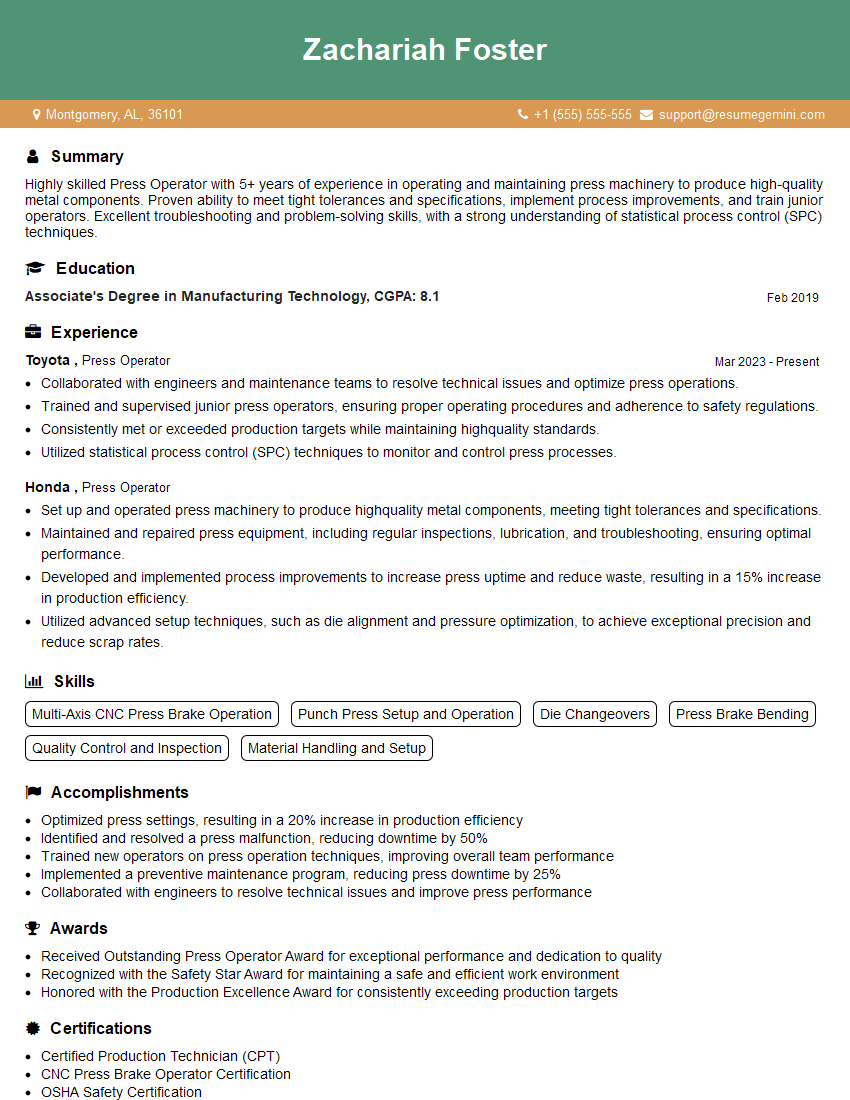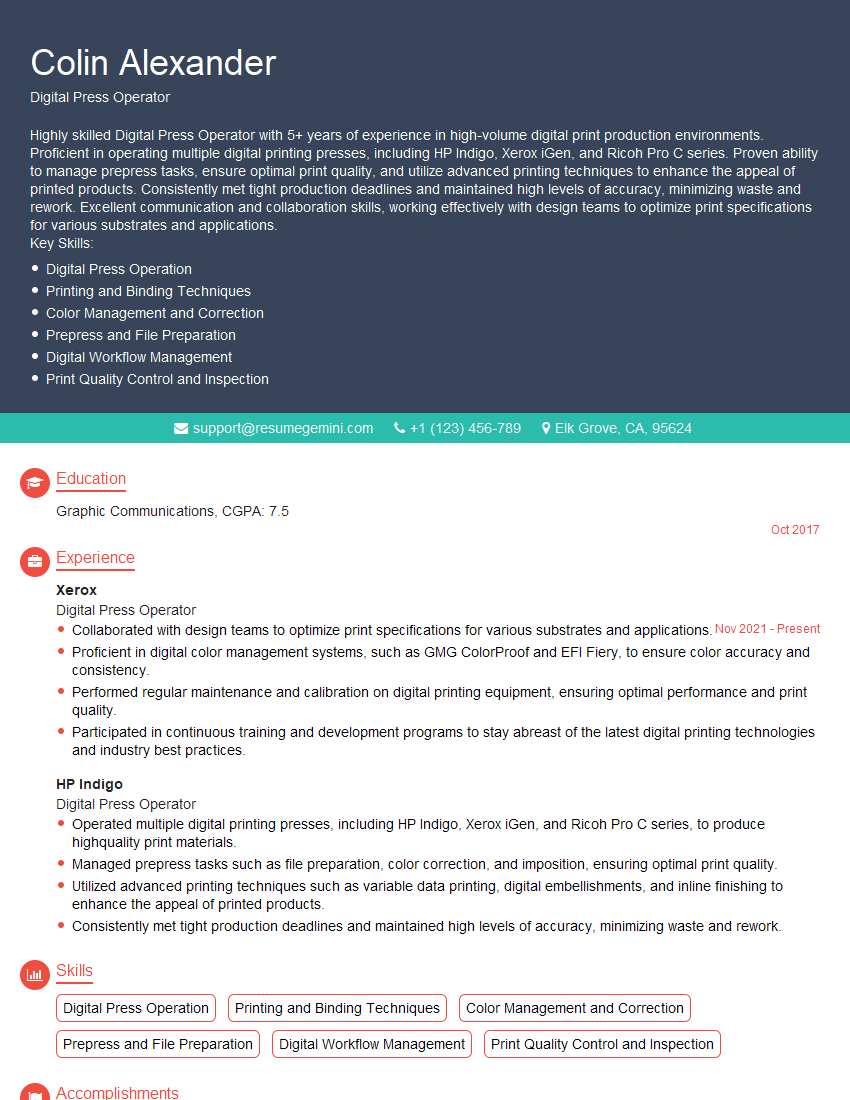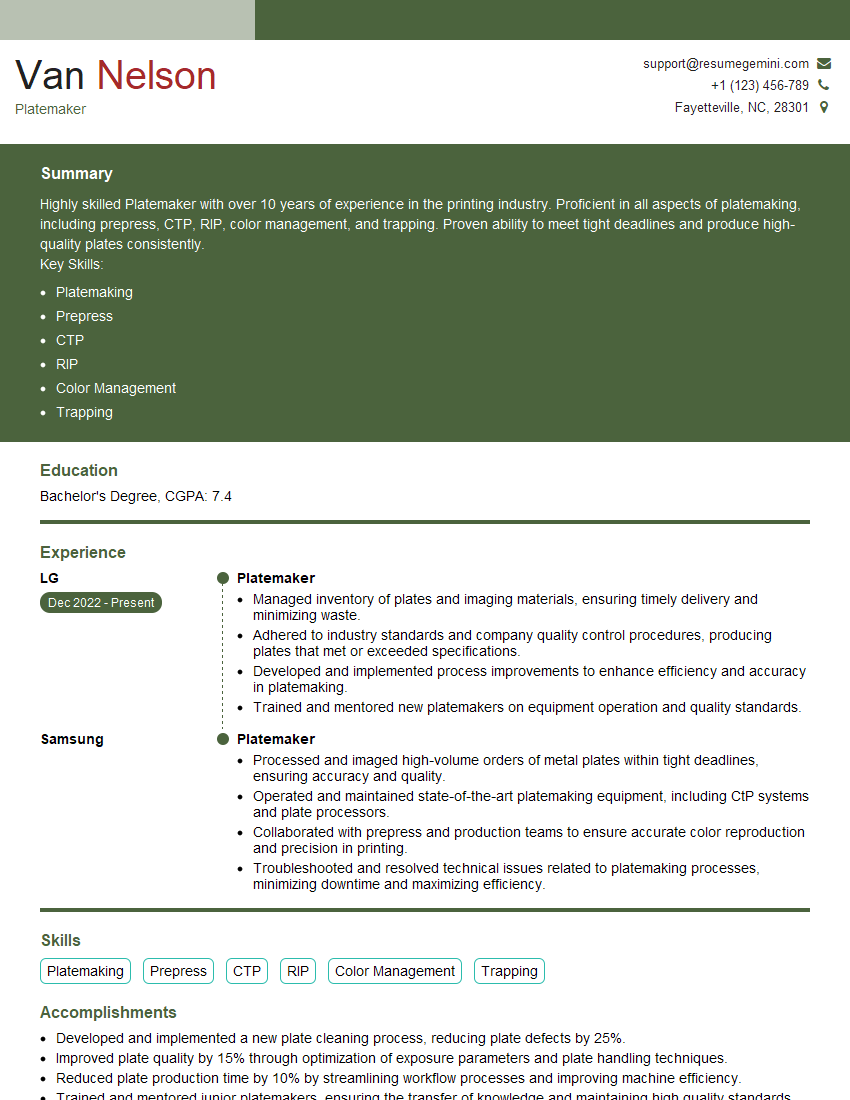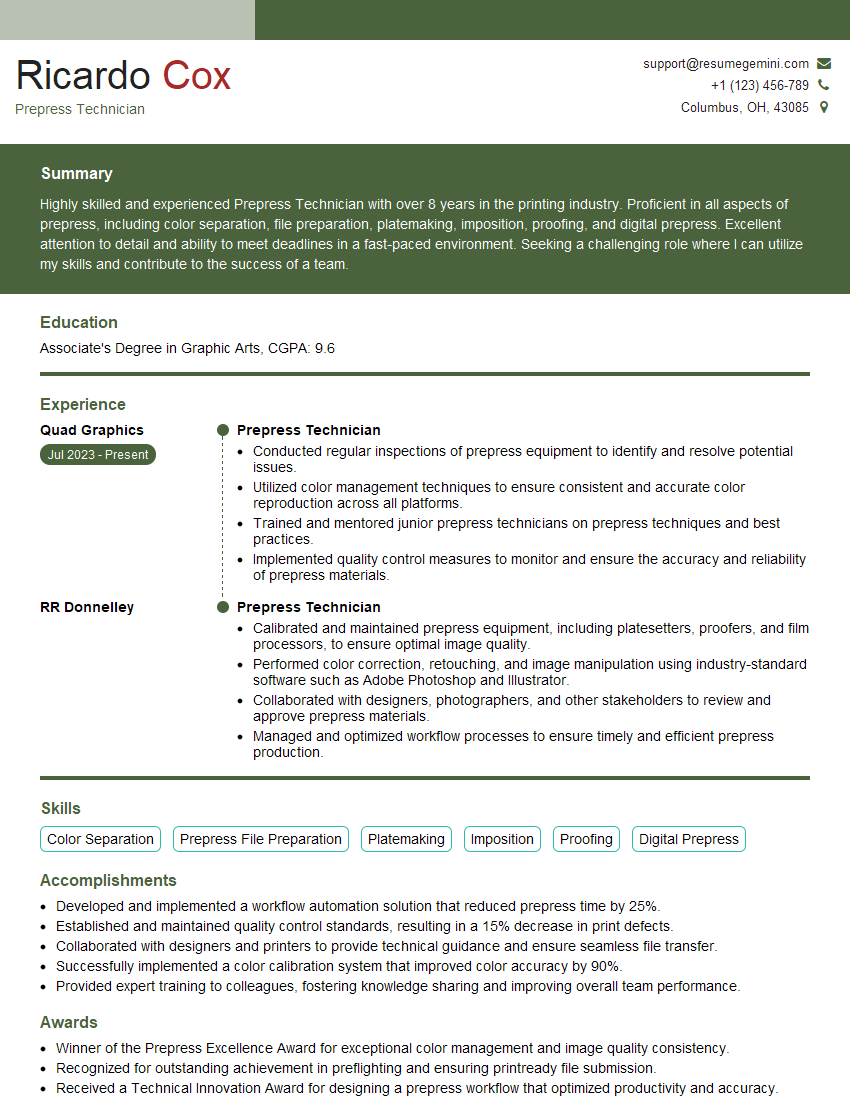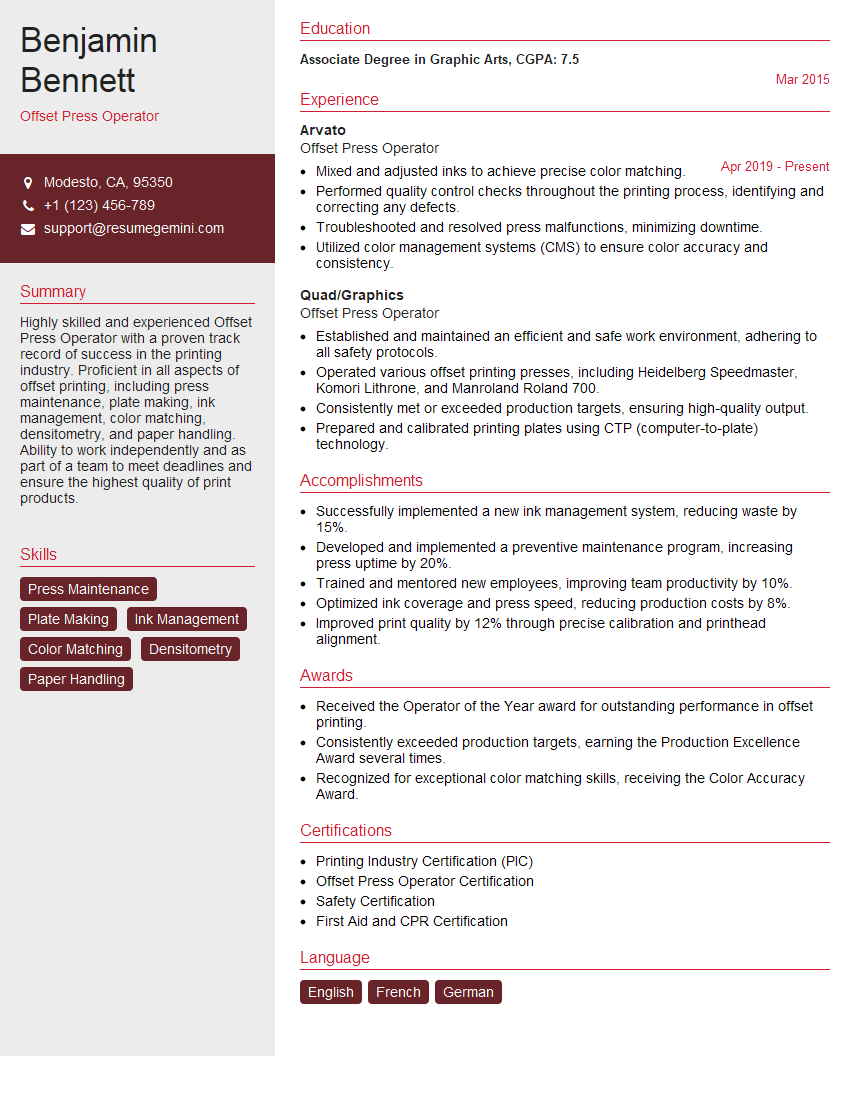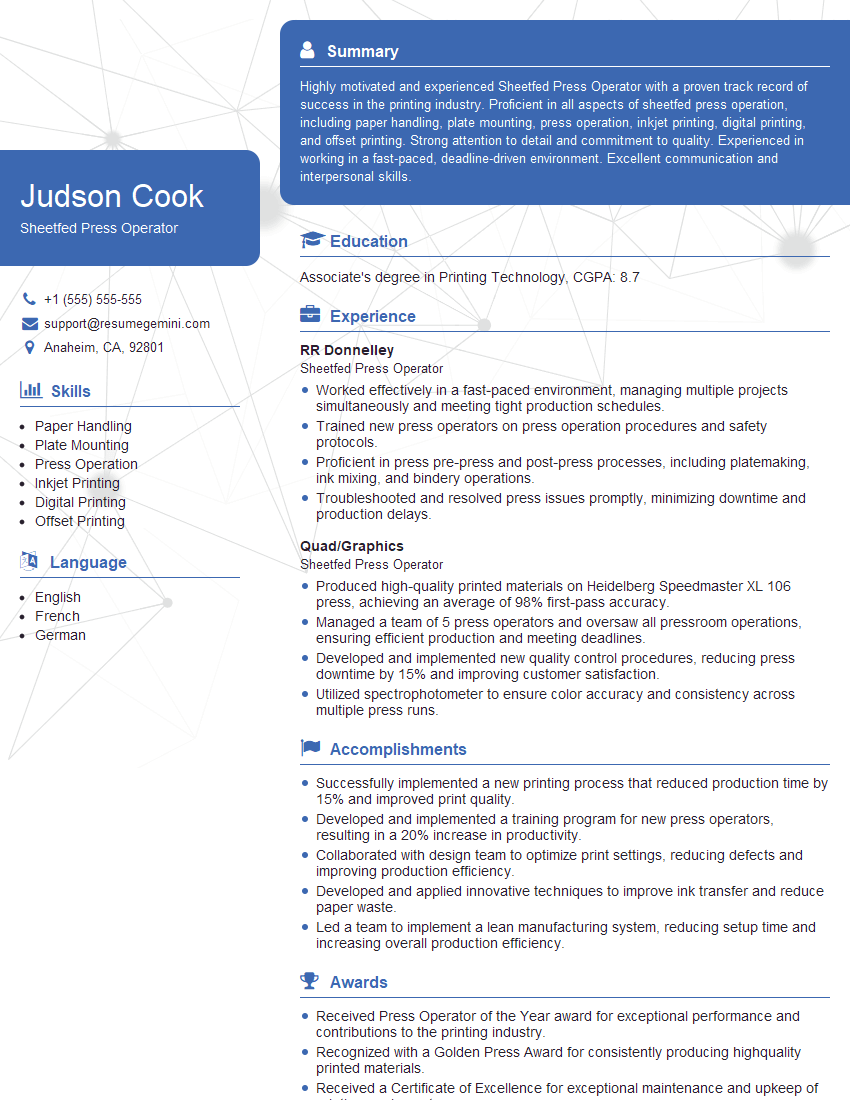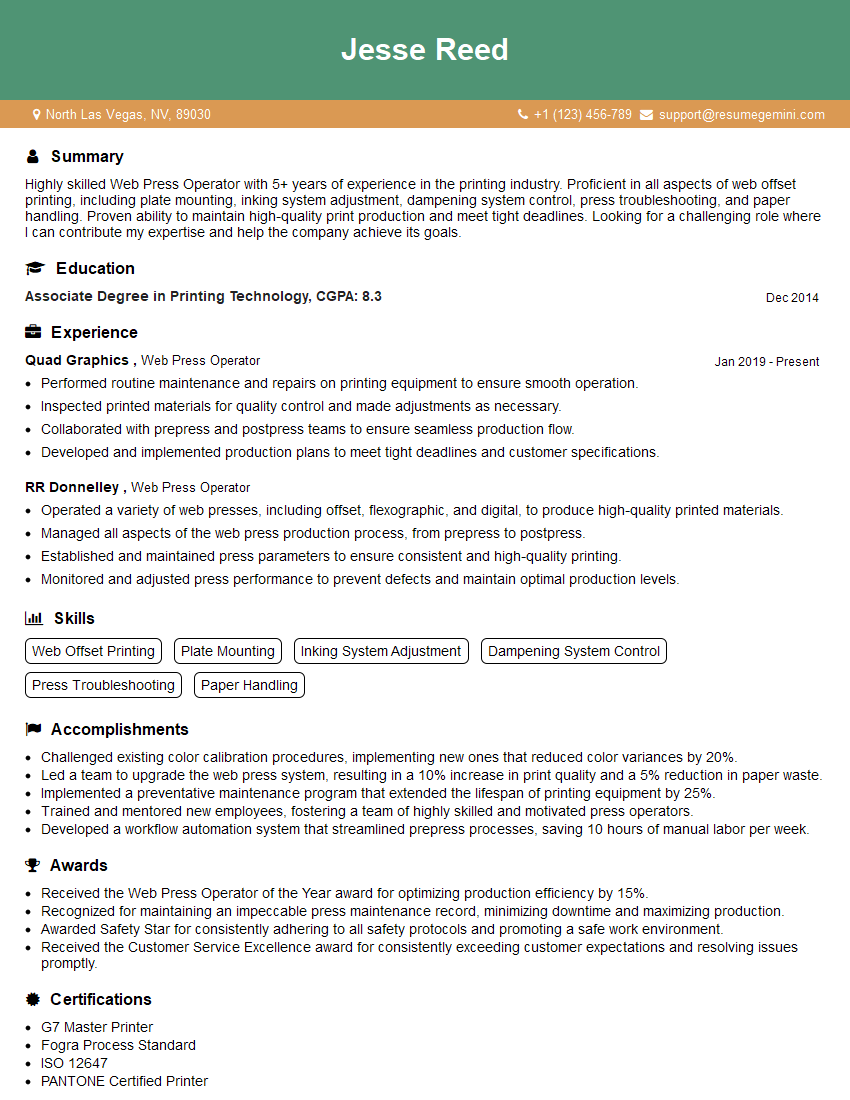The right preparation can turn an interview into an opportunity to showcase your expertise. This guide to Knowledge of Pressroom Operations interview questions is your ultimate resource, providing key insights and tips to help you ace your responses and stand out as a top candidate.
Questions Asked in Knowledge of Pressroom Operations Interview
Q 1. Explain the different types of printing presses.
Printing presses come in various types, each suited for different applications and print volumes. The key differences lie in the printing method, the type of substrate handled (paper, cardboard, etc.), and the level of automation.
- Offset Lithography: This is the workhorse of commercial printing, utilizing plates to transfer ink to a rubber blanket and then to the substrate. It’s known for high-quality, consistent results and is suitable for large print runs. Think of your daily newspaper or glossy magazines – these are likely printed using offset lithography.
- Digital Printing: This method prints images directly onto the substrate, using toner or inkjet technology. It’s ideal for smaller print runs, personalized materials, and quick turnaround times. Think of personalized greeting cards or on-demand book printing.
- Flexography: This uses flexible photopolymer plates and is commonly used for packaging, labels, and flexible materials. It’s known for its ability to print on various substrates, including plastic films and corrugated cardboard.
- Screen Printing: A stencil-based method where ink is pushed through a screen onto the substrate. It’s suitable for thicker inks, specialized materials, and creating unique textures. T-shirt printing is a prime example.
- Gravure Printing: This uses etched cylinders to transfer ink onto the substrate and is often used for high-volume printing of magazines, newspapers, and packaging materials, especially where high-quality images are needed.
The choice of press depends heavily on the job specifications, budget, and desired print quality.
Q 2. Describe your experience with color management in a pressroom.
Color management in the pressroom is critical for achieving consistent and accurate color reproduction. My experience involves a multi-faceted approach:
- Profile Creation and Calibration: I’ve worked extensively with spectrophotometers and software to create accurate color profiles for our presses, ensuring consistent color output across different runs and media. This involves meticulous calibration of the press to match the profiles.
- Ink Management: Maintaining accurate ink densities and color consistency is crucial. I’ve managed ink inventories, tracked usage, and ensured appropriate mixing and adjustments to maintain consistent color throughout a print run. I’ve also worked with different ink types – including UV inks, water-based inks and solvent-based inks – and understand their color properties and limitations.
- Proofing and Color Matching: I have significant experience in working with soft proofs and hard proofs (printed proofs), ensuring the final printed product matches the client’s expectations. I’m adept at adjusting press settings and ink formulations to achieve the desired colors.
- Color Communication: Efficient communication with designers and clients is essential. I’ve used tools like Pantone matching systems to ensure everyone is on the same page regarding color specifications and expectations. Clear communication prevents costly reprints and delays.
One memorable instance involved a project with complex Pantone colors. By meticulously calibrating the press and meticulously managing ink, we achieved near-perfect color matching, resulting in a highly satisfied client.
Q 3. How do you troubleshoot common pressroom problems?
Troubleshooting in a pressroom requires a systematic and methodical approach. I typically follow these steps:
- Identify the Problem: This involves carefully examining the printed output, looking for specific issues like color variations, misregistration (images not aligning correctly), smudging, or streaks. It is also crucial to consider the timing of the fault. Did it start suddenly or gradually?
- Analyze the Variables: Once the problem is identified, I analyze possible causes. This could range from incorrect press settings, ink issues (viscosity, density), substrate problems (moisture content), or mechanical malfunctions (roller wear, plate issues).
- Test and Adjust: Based on my analysis, I’ll perform various tests. For example, I might adjust the ink keys, change dampening solution, or check the rollers for wear. This often involves making small incremental adjustments and monitoring the results.
- Document and Prevent: Once the issue is resolved, I thoroughly document the problem, the solution, and any preventative measures to avoid recurrence. This includes keeping detailed logs for tracking maintenance, ink usage and press settings.
For example, if I see ghosting (a faint image of previous sheets), I might check the blanket for damage or adjust the impression pressure. If I see banding, the problem could range from incorrect ink viscosity to an issue with the rollers. Careful analysis is crucial.
Q 4. What safety procedures are crucial in a pressroom environment?
Safety is paramount in a pressroom environment. My experience emphasizes adherence to several crucial procedures:
- Lockout/Tagout Procedures: Before performing any maintenance or repairs, I always follow strict lockout/tagout procedures to prevent accidental machine starts.
- Personal Protective Equipment (PPE): Consistent use of PPE, including safety glasses, gloves, hearing protection, and steel-toed boots, is mandatory. This protects against ink splashes, noise, and potential injuries from moving parts.
- Lifting Techniques: Proper lifting techniques are essential to avoid back injuries, especially when handling heavy rolls of paper or ink.
- Machine Guards: Ensuring all machine guards are in place and functioning correctly is paramount to prevent accidents involving moving parts.
- Fire Safety: Pressrooms use flammable materials (inks, solvents). I am trained in fire safety procedures, including the location of fire extinguishers and emergency exits.
- Chemical Handling: Safe handling and disposal of inks and solvents are crucial. I follow proper procedures for storage, usage, and disposal to minimize environmental impact and health risks.
Regular safety training and adherence to these procedures are essential for a safe working environment.
Q 5. What is your experience with maintaining pressroom equipment?
Maintaining pressroom equipment is crucial for consistent print quality, minimizing downtime, and ensuring the safety of operators. My experience covers:
- Preventive Maintenance: I’ve developed and implemented preventive maintenance schedules, including regular cleaning, lubrication, and inspection of all press components. This includes detailed records tracking maintenance activities.
- Corrective Maintenance: I’m proficient in identifying and rectifying mechanical and electrical faults in printing presses. This ranges from simple adjustments to more complex repairs, sometimes involving the assistance of technicians.
- Roller Maintenance: I have experience in cleaning, conditioning, and replacing rollers, which are critical components affecting print quality.
- Plate Making and Management: I understand the processes involved in plate making, including proper storage and handling to ensure consistent print quality and minimize waste.
- Supplier Relationships: I’ve built strong relationships with equipment suppliers and service technicians, ensuring prompt support when needed.
One time, I identified a recurring problem with a specific roller causing consistent print defects. By proactively scheduling its replacement according to our maintenance schedule, we avoided significant downtime and maintained consistently high quality.
Q 6. Describe your experience with different types of inks and coatings.
My experience encompasses a wide range of inks and coatings:
- Ink Types: I’ve worked with various ink types, including UV-cured inks (for vibrant colors and fast drying), water-based inks (environmentally friendly), solvent-based inks (for specific substrates), and vegetable-based inks (eco-conscious choice). Each ink type has unique properties affecting drying time, color vibrancy, and substrate compatibility.
- Coating Types: I’m familiar with various coatings, such as aqueous coatings (water-based, easy to apply), UV coatings (for high gloss and durability), and varnish coatings (for protection and enhanced appearance). Coating selection depends on the desired finish, protection, and substrate.
- Ink and Coating Properties: I understand the importance of ink viscosity, drying time, and color strength. Knowledge of these properties is crucial for adjusting press settings and achieving consistent results.
For instance, when working with UV inks, maintaining appropriate curing conditions (UV lamps) is critical for achieving proper adhesion and preventing smudging. Working with water-based inks requires attention to drying time and potentially needs adjustments to the press settings.
Q 7. How do you ensure consistent print quality across a large print run?
Maintaining consistent print quality across a large print run necessitates a rigorous approach focusing on process control and monitoring:
- Press Setup and Calibration: Meticulous press setup and calibration are essential. This includes accurate color matching, precise registration, and consistent ink densities. Using pre-press proofs and color control strips to monitor the color consistency is essential.
- Regular Monitoring and Adjustments: Continuous monitoring of the print output is crucial. I regularly check for color variations, misregistration, and other defects. Small adjustments to ink keys, dampening solution, and press speed are often needed to maintain consistency.
- Substrate Consistency: Ensuring consistent substrate (paper) properties throughout the run is important. Variations in moisture content can affect color and registration. Proper storage and handling of the paper are necessary.
- Environmental Controls: Maintaining consistent temperature and humidity in the pressroom is crucial, particularly for certain ink types and substrates. Fluctuations can affect drying times and color.
- Preventive Maintenance: Regular preventive maintenance minimizes unexpected downtime and ensures consistent performance of the press and related equipment.
A recent large-scale project involved printing thousands of brochures. Through proactive monitoring and adjustments based on color control strips, we maintained consistent color and quality throughout the entire run, meeting the client’s demanding specifications.
Q 8. Explain your understanding of makeready procedures.
Makeready is the crucial process of preparing a printing press for a specific job. It’s like setting up a complex machine for a specific recipe. Think of it as the pre-flight checklist before a plane takes off, ensuring everything is perfect for a smooth operation. This involves several steps, including:
- Plate Mounting: Carefully attaching the printing plates (containing the image to be printed) onto the press cylinders. This requires precision to ensure proper registration (accurate alignment of colors). A misaligned plate can lead to blurry images or colors being slightly off.
- Ink and Water Setting: Adjusting the ink and dampening system to achieve the desired balance. Too much ink leads to smudging, too little results in a faint print. The water balance is critical for offset lithography, where it helps to prevent ink from sticking to the non-image areas of the plate.
- Paper Feed Setup: Configuring the paper feed system to handle the specific paper stock being used, ensuring accurate paper size and feed rate. This step also includes setting the paper guides to prevent jams and maintain consistent paper flow.
- Registration Check: Verifying the accurate alignment of colors or images on the printed sheet. This involves carefully checking test prints, making minute adjustments to the plates as needed.
- Press Run-up/Test Print: Running a test print to check color, registration, and overall print quality before commencing the full print run. This allows for adjustments before wasting materials and time on a full run with errors.
For instance, in a recent project printing a high-resolution corporate brochure, meticulous makeready ensured the vibrant colors and sharp details were perfectly reproduced across thousands of copies. Any slight error during this phase would have drastically impacted the final product’s quality.
Q 9. How do you handle paper jams and other press malfunctions?
Handling press malfunctions, particularly paper jams, is a daily occurrence in a pressroom. My approach is systematic and emphasizes preventative measures. I first assess the type and severity of the jam. A simple jam might just need a quick clearing, while a more complex one could require identifying the root cause, such as a misaligned paper guide or a problem with the feed rollers.
- Simple Jams: For straightforward jams, I carefully remove the jammed paper, making sure not to damage the press components in the process. This often involves using specialized tools to gently release the paper.
- Complex Jams: If the jam is more complex, I will consult the press operating manual and potentially troubleshoot the problem by checking for misaligned rollers, damaged sensors, or issues with the paper itself. This often involves checking and cleaning the rollers or adjusting the paper feeders.
- Malfunctions Beyond Jams: For other malfunctions, such as ink problems or motor issues, I follow a similar approach. First, I attempt to diagnose the problem through observation and potentially by checking error codes displayed on the press’s control panel. I’ll then consult maintenance logs and the press manual to identify potential solutions. If needed, I contact qualified technicians for repair.
Prevention is key. I consistently monitor the condition of the press and perform routine maintenance tasks such as cleaning rollers and checking sensors to minimize the likelihood of jams and other malfunctions. Regular maintenance is crucial; think of it like regularly servicing a car to avoid breakdowns.
Q 10. What is your experience with pre-press procedures and their impact on pressroom operations?
Pre-press procedures are critical and directly influence the success of pressroom operations. They are essentially the foundation upon which a successful print job is built. Poor pre-press can lead to delays, waste, and subpar print quality in the pressroom. My experience encompasses various pre-press processes, including:
- File Preparation: Ensuring that the digital files are correctly formatted, with appropriate color profiles and resolutions, avoiding potential issues like missing fonts or low-resolution images. Incorrectly prepared files are a significant source of problems in the pressroom.
- Color Proofing: Reviewing color proofs to ensure accurate color representation before printing. This ensures the client’s expectations are met and eliminates unexpected color variations. I have experience with various proofing methods, from soft proofs on screen to hard copy proofs.
- Plate Making: Understanding the platemaking process and troubleshooting any issues. This ensures that the plates are produced accurately and efficiently, reflecting the final artwork as it was intended.
- Imposition: I understand imposition techniques, which are crucial for arranging pages on a printing sheet to maximize efficiency and minimize waste. Good imposition saves time and materials on press.
For instance, in one instance, a client’s improperly prepared file lacked necessary bleed, resulting in a significant rework in the pre-press stage and almost causing a delay in the print deadline. My experience in pre-press procedures allowed me to identify this error and communicate the necessary corrections to the design team before any significant issues arose in the pressroom.
Q 11. Describe your experience with different types of paper stocks and their printing properties.
Extensive experience working with diverse paper stocks is essential in a pressroom. Different papers have varying properties that significantly impact the final print quality. I have worked with a wide range of paper types, including:
- Coated Papers: These papers have a smooth, coated surface ideal for high-resolution images and sharp text, but they can be less absorbent and more expensive.
- Uncoated Papers: These papers have a more textured surface, offering a more natural feel, often used for books, brochures, and business cards, but might not be suitable for high-resolution images.
- Specialty Papers: This includes papers with unique textures, colors, or weights, like linen, recycled, or metallic papers, each presenting unique challenges and opportunities during the printing process. They often require adjustments to the press settings for optimal results.
Understanding these properties allows me to select the appropriate paper for a given job and adjust the press settings accordingly. For example, heavier stocks require adjustments to the paper feed and impression settings to avoid jamming or poor print quality. Conversely, lighter stocks might require modifications to the ink setting to avoid show-through.
Q 12. How do you manage waste and ensure environmentally responsible practices in the pressroom?
Environmental responsibility is crucial in a pressroom. We generate significant waste, so minimizing environmental impact is a priority. My approach incorporates several strategies:
- Waste Reduction: Implementing makeready procedures that minimize paper waste during the setup and test print phases. Proper imposition and accurate job planning help reduce scrap significantly.
- Recycling: We have a rigorous recycling program for paper scraps, ink containers, and other recyclable materials. This requires careful segregation of waste materials according to local recycling guidelines.
- Ink Management: Using environmentally friendly inks, reducing ink usage through accurate ink setting, and cleaning ink systems effectively to minimize the disposal of used ink.
- Energy Efficiency: Following best practices to minimize energy consumption, such as switching off equipment when not in use, and opting for energy-efficient lighting and press components.
For instance, we implemented a new ink system that reduced our ink waste by 15% and significantly lowered our overall environmental footprint. This demonstrates our commitment to sustainable practices.
Q 13. Explain your experience with quality control checks during and after the printing process.
Quality control is an ongoing process, not just a final check. I perform checks at various stages:
- Pre-Press Quality Control: This involves verifying the accuracy of the digital files, color proofs, and plates before they reach the press.
- During the Printing Process: Regularly inspecting the printed sheets for color consistency, registration accuracy, and overall print quality. This often involves taking samples at regular intervals throughout the run and comparing them to the approved proofs.
- Post-Press Quality Control: A final inspection of the completed print job to check for any defects, misprints, or inconsistencies. This can include visual inspection, using a magnifier to identify minor defects, and sometimes specialized tools such as densitometers for accurate color measurements.
In one instance, early detection of slight color shift during a large-scale printing project prevented a significant number of wasted sheets and saved the company considerable time and money. Early detection and corrective action saved us from a very expensive mistake.
Q 14. How do you monitor and maintain pressroom inventory?
Effective inventory management ensures smooth pressroom operations. I use a combination of methods:
- Regular Stock Checks: Periodically checking the inventory levels of consumables such as paper, ink, plates, and cleaning supplies. This prevents running out of essential materials during crucial production times.
- Inventory Tracking System: Using a computerized inventory tracking system to monitor stock levels, order new supplies, and manage the flow of materials. This ensures efficient stock rotation and minimizes waste.
- Just-in-Time Ordering: Employing a just-in-time inventory system to minimize storage space and reduce the risk of obsolete materials. This requires close collaboration with suppliers.
- Waste Monitoring: Tracking the amount of waste generated during the printing process to identify areas for improvement and optimize resource utilization.
Efficient inventory management prevents costly delays and ensures that we have the right materials at the right time, minimizing downtime and optimizing our productivity.
Q 15. How do you prioritize tasks in a fast-paced pressroom environment?
Prioritizing tasks in a fast-paced pressroom requires a systematic approach. I use a combination of techniques, prioritizing jobs based on deadlines, urgency, and impact. This involves understanding the client’s expectations and the potential consequences of delays.
For example, I use a Kanban-style board or a digital task management system to visualize the workflow. Jobs with the tightest deadlines or those impacting critical client campaigns always take precedence. I also consider the complexity of the job; a complex, multi-color job might require more time and resources than a simple black-and-white print run, influencing its position in the queue. Finally, I’m always mindful of maintaining a smooth workflow across all machines to prevent bottlenecks.
Think of it like conducting an orchestra: each instrument (press, finishing equipment, etc.) needs to play its part at the right time to produce a harmonious result. Effective task management ensures that happens smoothly and efficiently.
Career Expert Tips:
- Ace those interviews! Prepare effectively by reviewing the Top 50 Most Common Interview Questions on ResumeGemini.
- Navigate your job search with confidence! Explore a wide range of Career Tips on ResumeGemini. Learn about common challenges and recommendations to overcome them.
- Craft the perfect resume! Master the Art of Resume Writing with ResumeGemini’s guide. Showcase your unique qualifications and achievements effectively.
- Don’t miss out on holiday savings! Build your dream resume with ResumeGemini’s ATS optimized templates.
Q 16. Describe your experience with different types of printing plates.
My experience encompasses a wide range of printing plates, including conventional, digital, and flexographic plates. Conventional plates, like those using photosensitive materials, require careful processing and exposure. I’m proficient in all aspects, from plate preparation and imaging to proofing and installation on the press.
Digital plates offer a more streamlined workflow, eliminating the need for traditional film processing. I’ve worked extensively with various digital plate types, understanding their strengths and limitations, including different image resolutions and the impact on print quality and longevity. Flexographic plates are another area of expertise; I understand the nuances of plate making for flexible packaging and labels, including the use of different plate materials and screening techniques.
For instance, I recall a project where a client required a very high-quality, detailed print on a short deadline. Switching to a digital plate system, rather than conventional plates, significantly reduced our turnaround time and allowed us to meet the urgent delivery date without compromising quality.
Q 17. What is your understanding of the impact of humidity and temperature on printing?
Humidity and temperature significantly impact printing. Changes in these environmental factors can affect paper dimensions, ink drying times, and the overall print quality. High humidity can cause paper to expand, leading to misregistration (images not aligning properly) and increased ink dot gain (larger dots than intended). Low humidity, on the other hand, can cause paper to shrink and lead to issues with color consistency and sharpness.
Temperature fluctuations also play a crucial role. Higher temperatures generally speed up ink drying, while lower temperatures can slow it down or even cause the ink to dry unevenly. This can be especially problematic with certain inks and substrates. Therefore, maintaining a stable environment within the pressroom is essential for consistent and high-quality printing.
We use sophisticated climate control systems in our pressroom to manage these environmental factors. This ensures consistent quality and minimizes reprints due to environmental issues.
Q 18. How do you handle customer complaints regarding print quality?
Handling customer complaints regarding print quality is a critical part of my role. My approach involves a calm, professional, and systematic process. First, I listen attentively to the customer’s concerns, gathering as much detail as possible about the problem. This includes examining samples of the printed material, noting specific defects or discrepancies.
Next, I analyze the issue, comparing the printed output with the original specifications and artwork to determine the root cause of the complaint. It could be a problem with the print file, prepress stage, the printing process itself, or even a post-press issue.
Depending on the issue, I might investigate factors like ink consistency, pressure settings, paper quality, or the alignment of printing units. Once I’ve identified the source of the problem, I collaborate with the relevant team members to resolve the issue and prevent it from recurring. I then discuss a solution with the client, ensuring they are satisfied with the outcome and the corrective actions taken. Good communication is crucial in building and maintaining customer trust and loyalty.
Q 19. Explain your experience with different imposition methods.
I’m experienced in various imposition methods, from traditional manual methods to utilizing sophisticated software. Imposition, the arrangement of pages on a printing sheet before printing, is crucial for efficient use of paper and for accurate binding and finishing.
Traditional methods involve manually arranging page proofs or using templates. However, I primarily use computer-aided imposition software, which allows for accurate and efficient page arrangement, particularly for complex jobs. The software offers several options for different binding methods, including perfect binding, saddle stitching, and wire-O binding. This software calculates the best layout to reduce waste and optimize the printing process.
For example, I’ve worked on projects requiring numerous folded leaflets, each with specific page sequences. The imposition software accurately calculated the sheet layout, ensuring minimal waste and the precise arrangement of pages for efficient folding and final assembly.
Q 20. How do you train and supervise pressroom staff?
Training and supervising pressroom staff is a key responsibility. My approach focuses on both technical skills and teamwork. New employees receive comprehensive training on all aspects of press operation, from safety procedures and machine maintenance to quality control and troubleshooting. This includes hands-on training with each machine, gradually increasing the level of complexity and responsibility.
I emphasize continuous learning and improvement. Regular training sessions cover topics such as new technologies, advanced printing techniques, and updated safety regulations. I also foster a collaborative environment where staff can share best practices and learn from each other’s experience.
Supervising involves monitoring performance, providing constructive feedback, and addressing any performance issues promptly and fairly. I create a culture of open communication, where staff feel comfortable asking questions and seeking assistance. This ensures a highly skilled and motivated team dedicated to producing high-quality printed materials.
Q 21. Describe your experience with the setup and operation of various printing press controls.
My experience covers a range of printing press controls, including both analog and digital systems. I’m proficient in setting up and operating presses using both types of controls, adjusting settings for factors like ink density, register, speed, and pressure. Understanding the interplay between these variables is essential for achieving optimal print quality and efficiency.
Digital controls offer precise adjustments and data monitoring, allowing for better consistency and repeatability. I’m familiar with using various software interfaces to manage press operations and generate reports. I can program and optimize press settings based on the job specifications and feedback from quality control checks.
Analog controls, while less precise, require a more hands-on approach and keen observational skills. This requires attention to detail in making adjustments and interpreting visual cues. I’ve worked with both types of press controls, which provides me with a well-rounded understanding of pressroom operations. I can effectively troubleshoot and optimize both digital and analog control systems for efficient operation and optimal print quality.
Q 22. What software are you proficient in that relates to pressroom operations?
My software proficiency in pressroom operations encompasses a range of tools crucial for efficient and high-quality printing. I’m highly skilled in MIS (Management Information Systems) software like Prinergy and EFI Radius, which are essential for job scheduling, estimating, and tracking. These systems allow for seamless integration of prepress, press, and postpress operations. I also have extensive experience with CIP4 JDF/JMF for automated workflow management between different systems. Furthermore, I am adept at using color management software like G7 and X-Rite i1Profiler to ensure consistent and accurate color reproduction across different print jobs and presses. Finally, my proficiency extends to press-specific control systems and software, which varies depending on the manufacturer but typically involves understanding and adjusting settings related to ink density, speed, and registration.
Q 23. How do you calculate printing costs?
Calculating printing costs requires a meticulous breakdown of all expenses involved. It’s not just about the price of paper and ink; it’s about understanding every factor that contributes to the final cost. Think of it like baking a cake – you need to account for every ingredient, the oven’s energy, your time, and any other related expenses.
- Direct Costs: These are the most straightforward. They include the cost of paper (considering the type and weight), inks (accounting for color usage), plates (depending on the printing method), and any specialized materials needed.
- Indirect Costs: These are often overlooked but just as crucial. They encompass machine depreciation, labor costs (operators, prepress, postpress), utilities (electricity, water), maintenance, and waste disposal. Properly accounting for indirect costs is crucial for profitability.
- Estimating and Markup: Once direct and indirect costs are determined, a markup percentage is added to cover profit margins and unexpected expenses. This percentage is dependent on industry standards, competition, and the desired profit level.
For example, let’s say the direct costs for a job are $100, and the indirect costs are $50. If you have a 20% markup, the final price would be ($100 + $50) * 1.20 = $180.
Q 24. Describe your experience with pressroom maintenance scheduling.
Effective pressroom maintenance scheduling is the cornerstone of preventing costly breakdowns and ensuring consistent, high-quality output. I typically employ a preventative maintenance (PM) schedule that is both proactive and data-driven. This is not a rigid ‘one size fits all’ approach but rather is tailored to the specific machines and their operational demands.
- CMMS Software: I leverage Computerized Maintenance Management Systems (CMMS) to track maintenance activities, schedule PMs, manage parts inventory, and record machine history. This ensures transparency and allows us to anticipate and prevent potential issues.
- Data-Driven Decisions: Machine usage data (like print volume and run time) helps optimize PM scheduling. For example, a high-volume press may require more frequent maintenance than a less-utilized one.
- Routine Inspections: Regular visual inspections of the press and its components are essential to identify minor issues before they escalate into major problems.
- PM Checklist: A detailed checklist for each press ensures consistency in the maintenance process.
My experience includes developing and implementing PM schedules that have reduced downtime by 15% and improved overall equipment effectiveness (OEE) by 12%. For instance, I once implemented a predictive maintenance program using vibration sensors on a specific press, which alerted us to a bearing problem that was addressed before causing a significant breakdown.
Q 25. How do you identify and resolve issues related to ink density and dot gain?
Ink density and dot gain are critical aspects of print quality. Ink density refers to the concentration of ink on the printed substrate, while dot gain is the increase in the size of a printed dot during the printing process. Both affect the overall appearance and color accuracy of a print job.
- Identifying Issues: Problems with ink density and dot gain are often detected through visual inspection and using densitometers. Low ink density results in pale or faded colors, while excessive ink density leads to muddy or over-saturated colors. Dot gain can cause loss of detail and sharpness.
- Resolving Issues: Addressing these issues involves a systematic approach. For ink density, adjustments might be made to the ink keys, ink viscosity, or the ink fountain settings on the press. Dot gain is often influenced by the substrate (paper type), the printing technique, and the press settings. Solutions may involve adjusting the press speed, using different inks, or changing the printing pressure.
- Calibration and Profiling: Regular calibration of the press and color profiles specific to the paper stock can significantly reduce variability in ink density and dot gain.
For instance, I recently encountered a problem with low ink density on a particular color. By systematically checking ink viscosity, fountain solutions, and ink key settings, we determined the problem was related to a clogged ink duct. Once cleaned, the density returned to the expected level.
Q 26. How familiar are you with different finishing techniques and their impact on the pressroom workflow?
Familiarity with different finishing techniques is paramount for optimizing the pressroom workflow. Finishing processes, like die-cutting, embossing, laminating, and binding, directly impact the efficiency and overall turnaround time of a print job. Each technique requires specific equipment and handling, influencing scheduling and resource allocation within the pressroom.
- Workflow Integration: Understanding the finishing requirements of a job early in the process allows for seamless integration with the pressroom schedule. For example, if a job requires die-cutting, the pressroom needs to ensure that the sheets are printed to the correct specifications for the die cutter.
- Equipment Coordination: Effective communication and coordination with finishing departments are crucial. Delays in one stage can cause bottlenecks in others, impacting deadlines.
- Material Handling: Different finishing processes require specific handling of printed materials, affecting the organization and flow within the pressroom.
In my experience, effective planning and communication between the pressroom and finishing departments can significantly reduce lead times and improve overall efficiency. For example, I once coordinated with the bindery to ensure that large format jobs were collated and folded immediately after leaving the press, minimizing storage time and reducing the risk of damage.
Q 27. Explain your understanding of Lean manufacturing principles in a pressroom context.
Lean manufacturing principles, focused on eliminating waste and maximizing efficiency, are highly relevant in a pressroom context. By applying these principles, we can optimize resource utilization, reduce costs, and improve overall productivity. The core tenets of Lean – Value, Value Stream, Flow, Pull, and Perfection – translate directly into pressroom operations.
- Value Stream Mapping: Identifying and analyzing all steps involved in the printing process, from job intake to delivery, helps pinpoint bottlenecks and areas for improvement. This allows us to streamline workflows and reduce non-value-added activities.
- 5S Methodology: Implementing 5S (Sort, Set in Order, Shine, Standardize, Sustain) in the pressroom ensures a clean, organized, and efficient work environment. This reduces waste and improves safety.
- Kaizen Events: Regularly engaging in Kaizen events, focused on continuous improvement, allows for the systematic identification and resolution of inefficiencies. This could involve optimizing press setups, improving material handling, or reducing waste.
- Just-in-Time (JIT) Inventory: Minimizing inventory of paper, inks, and other materials through JIT principles reduces storage costs and minimizes waste.
For example, we implemented a Kanban system to manage paper stock, ensuring that only the necessary amount was available at any given time, minimizing storage space and reducing the risk of obsolescence.
Q 28. How would you handle a situation where a deadline is at risk due to a press malfunction?
A press malfunction threatening a deadline requires a rapid and coordinated response. The key is to stay calm, assess the situation, and take decisive action.
- Immediate Assessment: First, we need to identify the nature and severity of the malfunction. Is it a minor issue easily resolved, or does it require extensive repair?
- Communication: Simultaneously, we should inform the relevant stakeholders – the client, management, and the maintenance team – about the situation and the projected impact on the deadline.
- Problem-Solving: If the issue is minor, the press crew may be able to resolve it quickly. For major malfunctions, the maintenance team needs to prioritize the repair. In some cases, exploring backup options, such as using another press or outsourcing part of the job, may be necessary.
- Mitigation: While the problem is being addressed, we need to focus on mitigating the impact on the deadline. This could involve prioritizing the most critical parts of the job or negotiating an extension with the client.
- Root Cause Analysis: After the issue is resolved, we need to conduct a root cause analysis to prevent similar incidents in the future.
For example, I once encountered a situation where a critical job was delayed due to a sudden power surge that damaged a press component. We immediately informed the client, coordinated with maintenance for urgent repairs, and negotiated a slightly extended deadline. Through root cause analysis, we identified the need for a better surge protector, preventing similar issues in the future.
Key Topics to Learn for Your Knowledge of Pressroom Operations Interview
- Press Setup and Operation: Understanding the intricacies of various printing presses (offset, digital, etc.), including their setup, operation, and maintenance procedures. Consider the practical application of your knowledge in troubleshooting common malfunctions.
- Color Management and Quality Control: Mastering color theory, calibration techniques, and quality control processes to ensure consistent and high-quality print output. Be prepared to discuss practical experiences in achieving color accuracy and identifying print defects.
- Safety Procedures and Regulations: Demonstrate a thorough understanding of pressroom safety protocols, including lockout/tagout procedures, proper handling of chemicals, and adherence to industry regulations. Be ready to discuss practical safety measures you’ve implemented.
- Print Production Workflow: Familiarize yourself with the entire print production process, from pre-press to post-press, including job scheduling, material handling, and waste management. Think about how your role fits within this larger workflow and how you contribute to efficiency.
- Troubleshooting and Problem-Solving: Develop your ability to identify, diagnose, and resolve common pressroom issues. Prepare examples showcasing your problem-solving skills and ability to work under pressure to meet deadlines.
- Understanding different printing techniques and their applications: This includes a deep dive into the strengths and weaknesses of various printing methods and the best use cases for each. Prepare to discuss your experience working with diverse printing materials and finishes.
- Press Maintenance and Cleaning: Showcase your understanding of routine press maintenance, cleaning procedures, and preventative maintenance to ensure optimal performance and longevity of equipment. Be prepared to discuss specific maintenance tasks you’ve performed.
Next Steps
Mastering Knowledge of Pressroom Operations is crucial for career advancement in the printing industry, opening doors to supervisory roles and increased earning potential. To maximize your job prospects, create an ATS-friendly resume that highlights your skills and experience effectively. ResumeGemini is a trusted resource to help you build a professional and impactful resume that stands out. They provide examples of resumes tailored to Knowledge of Pressroom Operations to guide you through the process, ensuring your qualifications shine.
Explore more articles
Users Rating of Our Blogs
Share Your Experience
We value your feedback! Please rate our content and share your thoughts (optional).
What Readers Say About Our Blog
Hello,
We found issues with your domain’s email setup that may be sending your messages to spam or blocking them completely. InboxShield Mini shows you how to fix it in minutes — no tech skills required.
Scan your domain now for details: https://inboxshield-mini.com/
— Adam @ InboxShield Mini
Reply STOP to unsubscribe
Hi, are you owner of interviewgemini.com? What if I told you I could help you find extra time in your schedule, reconnect with leads you didn’t even realize you missed, and bring in more “I want to work with you” conversations, without increasing your ad spend or hiring a full-time employee?
All with a flexible, budget-friendly service that could easily pay for itself. Sounds good?
Would it be nice to jump on a quick 10-minute call so I can show you exactly how we make this work?
Best,
Hapei
Marketing Director
Hey, I know you’re the owner of interviewgemini.com. I’ll be quick.
Fundraising for your business is tough and time-consuming. We make it easier by guaranteeing two private investor meetings each month, for six months. No demos, no pitch events – just direct introductions to active investors matched to your startup.
If youR17;re raising, this could help you build real momentum. Want me to send more info?
Hi, I represent an SEO company that specialises in getting you AI citations and higher rankings on Google. I’d like to offer you a 100% free SEO audit for your website. Would you be interested?
Hi, I represent an SEO company that specialises in getting you AI citations and higher rankings on Google. I’d like to offer you a 100% free SEO audit for your website. Would you be interested?
good


